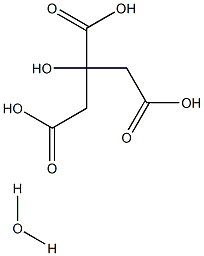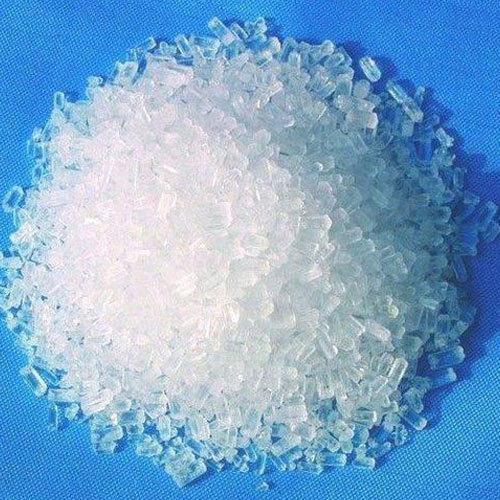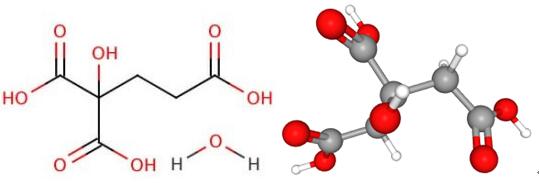General description of Citric Acid Monohydrate
General description
Citric Acid Monohydrate is a tricarboxylic acid found in citrus fruits. Citric acid is used as an excipient in pharmaceutical preparations due to its antioxidant properties. It maintains stability of active ingredients and is used as a preservative. It is also used as an acidulant to control pH and acts as an anticoagulant by chelating calcium in blood. Citric acid monohydrate is an organic molecular entity.
Application and pharmacology
The commercially available citric acid mainly includes anhydrous citric acid and citric acid monohydrate. Citric acid monohydrate accounts for more than 75% of the total output in the food industry. It is mainly used as sour agent, antioxidant and pH regulator in food. It can also be used as seasoning agent for cool drinks, jam, fruits or cakes. At the same time, it is also used in pharmaceutical industry, chemical industry, electronics, textile, petroleum, leather, photography, plastics, ceramics, casting and construction. Citric acid is mainly used as stabilizer and fiber crosslinking agent in the papermaking industry. Microbial citric acid has high economic importance and widely used in beverage, food, detergents, cosmetics and pharmaceutical industries. The filamentous fungusAspergillus nigeris a work horse and important cell factory in industry for the production of citric acid. Although in depth literatures and reviews have been published to explain the biochemistry, biotechnology and genetic engineering study of citric acid production.[1]
1.After adding Citric Acid into the slurry, the microorganisms in the system and paper are more effectively controlled, and the flushing cycle is significantly prolonged. Moreover, the physical index of paper is improved, the production cost is significantly reduced, and the operation stability of the system is improved.[2]
2. Citric acid is the largest organic acid produced by biochemical methods in the world. It is mainly used in food industry, such as sour agent, solubilizer, buffer, antioxidant, deodorizer, flavor enhancer, gelling agent, toner, etc., and in medicine, feed, chemical industry, electronics, textile, petroleum, leather, construction, photography, plastics Casting and ceramics and other industrial fields have very broad applications.
3.Citric acid is the most widely used sour agent in the world. Fujian accounts for more than 60% of the amount of food sour agent. It has a mild and refreshing sour taste. It is combined with sodium citrate to make the sour taste softer. It is mainly used in fruit juice, jelly, jam, fruit sugar, popsicle, ice cream, food, pastry, etc. it can also be used as antioxidant and pH regulator for canned vegetables such as tomatoes, beans and carrots, As an important food sour agent, citric acid can not only improve food flavor, but also inhibit microbial growth, protect color, improve viscosity and rheology.[3,4]
Synthesis
At present, the production method of citric acid monohydrate crystal in industry includes first separating the citric acid fermentation liquid from solid-liquid to obtain citric acid clear liquid, Citric acid clear night through calcium salt method The purified solution obtained by (hydrogen calcium method), acidolysis and decolorization is heated, concentrated and crystallized to produce anhydrous citric acid. The mother liquor separated from anhydrous citric acid crystal slurry is put into the crystallization cylinder after being filtered by plate and frame, and the citric acid concentrated solution reaches the supersaturated state through cooling to precipitate the crystal. When the temperature is reduced to about 13 ℃, centrifugal separation is started, and the wet crystal enters the dryer for drying dry. After the mother liquor is filtered, decolorized and concentrated by plate and frame, it is injected into the crystallization cylinder, and the above steps are repeated for cooling crystallization, centrifugal separation and drying. In this way, it is repeated four to five times. Finally, the separated mother liquor is returned to the extraction workshop after chromatographic separation for re purification.[5]
These enzymes play very important role for the production of several intermediates, required for biomass formation. Therefore, citric acid accumulation may more likely be the result of enhanced (deregulated) biosynthesis rather than inhibited degradation:
Figure1.Production of citric acid by A. niger (PFK ¼ phosphofructokinase, PC ¼ pyruvate carboxylase, ACO ¼ aconitase
Storage
The experiment shows that when citric acid monohydrate is stored at 40 ℃, the product moisture will gradually decrease, that is, the product will lose some water due to high temperature and exist in the packaging bag in gaseous state. When the temperature drops, the gaseous water will condense into water droplets and penetrate into the product particles, and the particle surface will melt and stick together, or the dehydrated particles share a water molecule to form caking. Therefore, citric acid production enterprises must attach great importance to storage conditions, which is one of the key factors affecting product quality. Although the production process and equipment are important, the storage conditions of products can not be controlled by the production process, production process control and product storage. Select the best equipment, production process and storage conditions to continuously reduce the production cost and improve the quality of products. Only in this way can we occupy the top and lead the development of the industry.
Reference
1.Behera B. C., "Citric acid from Aspergillus niger: a comprehensive overview," Critical reviews in microbiology, Vol.46, No.6(2020), pp.727-749.
2.Chen Hongjun: application of citric acid monohydrate in the production of lining paper for sanitary materials, paper and papermaking, No. 11, 2015, pp. 12-13.
3.Wang Doren: development and application progress of citric acid (sodium), chemical intermediates, 2004, issue 05, page 30-36.
4.Ren Hongjun: citric acid, an important food additive, chemical technology market, 2002, issue 07, page 23-25.
5.Yang Kelin: Research on citric acid monohydrate production process, chemical design communication, 2016, issue 04, page 194-195.
);You may like
Related articles And Qustion
See also
Lastest Price from Citric acid monohydrate manufacturers
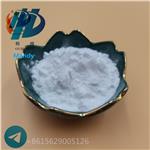
US $15.00/kg2024-04-18
- CAS:
- 5949-29-1
- Min. Order:
- 1kg
- Purity:
- 99.912%
- Supply Ability:
- 10ton
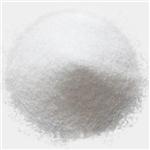
US $970.00/Tons2024-04-18
- CAS:
- 5949-29-1
- Min. Order:
- 10Tons
- Purity:
- 99.99%
- Supply Ability:
- 100Tons
